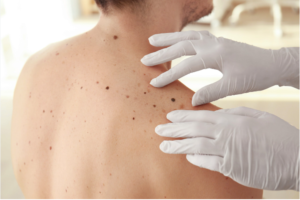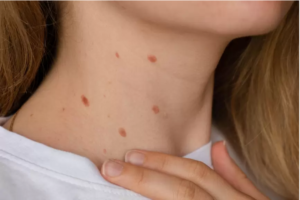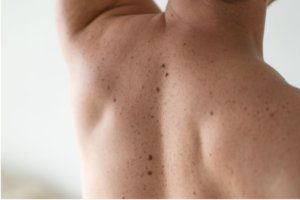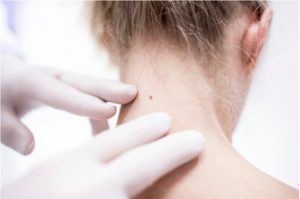Almost everyone in his life has experienced some type of mole. It is a discolored growth on the skin. Mole on face or body appear when there is an overgrowth of skin pigmentation cells. Certain risk factors can make them more likely to appear on skin.
It is estimated that many adults have somewhere between 10 and 40 moles on their body. While most are harmless. There is a chance that some raised mole may develop into melanoma. It is one of the serious types of skin cancer. Keep Reading for more facts about moles.
Table of Contents
Life Cycle of a Mole:
The life cycle of an average mole on our body is about 50 years. As the years pass, they usually change slowly. It becomes raised and lighter in color. And sometimes hairs develop on the mole. Some moles will not change and some will slowly disappear over time from the skin. Types of Moles

types of moles
Types of Moles on Face:
The main different types of moles are given below:
Common Nevi:
This is a normal mole or a small growth on your skin. It is pink, tan, or brown and has a clear edge.
Congenital Nevi:
These moles appeared on your skin when you were born. It occurs in about one in 100 people. These moles may be more likely to develop into melanoma than the moles that appear after birth. If a mole on your body is more than eight millimeters in diameter, it has a greater risk of becoming cancerous.
Dysplastic Nevi:
These moles are larger than a pencil eraser and are irregularly shaped. It tends to have an uneven color with dark brown centers and lighter, and uneven edges. These moles tend to be hereditary and people who have them may have more than 100 moles.
If you have dysplastic nevi then you have a big chance of developing malignant or cancerous melanoma. Any changes in a mole should be checked for skin cancer by a dermatologist immediately.
What Causes Moles:
Moles on skin develop when there is an overgrowth of the skin cells which are known as melanocytes. It gives our skin its color. This process commonly starts in adolescence. The researchers have also noted that moles may be likely to develop when our hormone levels are changing such as during puberty or pregnancy.
Are Lesions Similar as moles:
A pigmented lesion is a general term that includes normal moles, sun freckles, age spots or lentigines. While many of the pigmented lesions will not become cancerous. If you have many lesions or unusual lesions you should see a dermatologist on a regular basis for examination of a full skin.
Regular monitoring allows the dermatologist to determine the changes in lesions that look suspicious. A change may cause a skin biopsy. It is removing a sample of the types of moles for detailed examination under a microscope. It can help determine whether a lesion is non-cancerous or benign, melanoma or another type of skin cancer.

types of moles
Risk Factors:
Anyone can develop a mole, there are a few risk factors that can make it more likely that you will. These includes:
- Fair skin that sunburns more easily than it tans.
- Light hair on body.
- A family history of moles.
- Repeated exposure in the sun.
How Are Moles Diagnosed?
Many moles are harmless, and they don’t necessarily require an official diagnosis.
That said, it is a good idea to keep a mental note of what any current moles on your body look like. so that you can have any suspicious spots checked out by a healthcare provider. They will be able to visually examine your mole and potentially take a biopsy if needed to identify whether it is a harmless growth, or a melanoma. The Signs that a mole may be diagnosed as a melanoma such as changes in the size of growth, shape, color, and texture.
Treatments for Moles:
- Most moles did not require any particular treatment.
- But there are a couple of signs that might need the removal of the mole. This type of treatment is usually suggested when a mole is:
- Suspected to be melanoma(cancerous mole)
- Easily Frustrated
- Raised to the point where it may be grazed by shaving
- Catching on items like clothing or jewelry
- Annoying in appearance
Removal of mole can take place in a healthcare provider’s office. They usually use a couple of different methods to do so and these are:
Surgical removal:
It involves cutting out the complete mole from underneath the skin and using stitches to close the slit.
Surgical shaving:
It involves using a professional blade tool to eradicate the mole from the top most layer of the skin. If the mole is looking strange, a healthcare provider will send a skin cell sample to the laboratory. It can be checked out under the microscope. Mole removal is not a DIY project that you should do at home. Experts warn that trying to eradicate one yourself could lead to injuries, infection, or scarring. Even potentially delay the diagnosis and treatment of skin disease, such as melanoma.
How to Prevent Moles
While there is no surefire way to prevent moles from developing, there are many tips that experts suggested for protecting your skin health overall.
Perform skin self-exams:
- Keep your skin protected from the rays of sun.
- See a healthcare provider right away if you notice a mole that is changing in looking, itching, or bleeding.
- Seek out the routine preventive skin exams from a healthcare provider, specially if you have 50 or more than 50 moles.
Complications:
- A major potential complication of having moles is melanoma. If you have many moles, data shows you are more likely to be at a higher risk for developing melanoma.
- If a skin growth that is actually a melanoma goes untreated, there is the potential for this cancer to spread to other parts of the body including Nearby tissues, Lungs, Bones, Liver, and Brain.
Mole removal:
You might decide to have a mole taken away for a variety of reasons. Some moles may bother you because of the mole size or location. Other moles may need to be removed because your dermatologist is concerned about the melanoma. No matter what, you should never try to eliminate a mole on your own. This can potentially lead to the infection. If the mole is cancerous, you may miss an opportunity for early diagnosis.

raised mole
Generally, A typical moles are considered precancerous. Most of these moles don’t turn into cancer. When a dermatologist removes a mole, they will typically shave smaller moles or surgically excise larger ones or those that are cancerous. Depending on how large the mole is, stitches may be important to seal the area afterward. It can take two appointments to completely eliminate a mole.
When to Seek Doctor:
Generally, Dermatologists suggest that all adults get an annual skin checkup at least by their early 20s. This allows them to examine a person’s existing moles for the changes and growth of potentially cancerous ones. But if you spot any changes to your skin between checkups, they often suggest you make another appointment.
Some changes that guarantee a check up include:
- any new or fast growing moles
- a mole that suddenly changes it shape or size
- moles that are extremely itchy or irritated
- any mole that bleeds on its own without injury or any infected
- a dark line on your nail
What Is Melanoma:
It is a serious form of skin cancer that can develop in existing or new moles.
Mole Symptoms:
There typically are not any physical symptoms that come along with moles, other than noticing their appearance on the body. But sometimes, they can be itchy, or change in appearance if they are inflamed, such as after being scratched. But common moles do have a particular set of features that differentiate them from melanoma, skin cancer or other skin growth. Types of Moles
Overall, experts say the common moles are usually:
- Mostly in one color
- Flat and raised slightly
- Round or circular-shaped
- Mostly fixed in their appearance, at least in the short-term
While most common moles may share these same characteristics. Keep in mind that they can vary from person to person. For example, moles can:
- Appear anywhere on the skin, such as areas like the soles of the feet, palms, scalp, and under the nails
- They Differ widely in shape, size, and color.
- They Have hair growing on them.
- They Change slowly over time, get darker or lighter, and potentially disappear altogether.
Which Moles Lead to Cancer:
Most moles are normal and do not lead to cancer. However, they can progress to skin cancer as a result of the damage that Ultraviolet rays cause to melanocytes. Types of Moles
They are not supposed to change in size, shape, or texture. Do Contact your healthcare provider if your mole has any of the following ABCDEs of skin cancer:
Asymmetry:
Two halves of the mole that did not match if you drew a line down the center.
Border:
Uneven or irregular borders and possibly with notched or ragged edges.
Color:
Removal of color or a change to multiple shades of brown or black that’s sometimes mixed with gray, white, blue, or red color.
Diameter:
They are Larger than one-quarter inch.
Evolution:
Evidence of change in the appearance of a mole.
While most normal moles on the same person are similar to one another. They stand out as an “ugly duckling” as compared to the other moles.
Diagnosing Cancerous Moles:
They usually begins with a comprehensive physical examination that includes:
- Questions about mole symptoms like pain, itching, and bleeding.
- Review of the risk factors for skin cancer like sunburn history or family history of skin cancer
- Visual examination of the mole with attention to the mole size, shape, color, texture, and other attributes of the mole.
If your provider identifies the mole may be cancerous, they will perform a skin biopsy to diagnose it. This involves eliminating a section of the infected area and sending it to a lab for evaluation under a microscope.
Skin Biopsy:
The most common technique that is used to perform a skin biopsy. It include the following:
Shave biopsy:
With a shave biopsy technique, the top layers of the mole are shaved off with a small blade. It is used for superficial moles that are primarily located on the epidermis without extending to the deeper layers of your skin.
Punch- biopsy:
Punch Biopsy involves the use of a tool. It looks like a tiny round cylinder to eliminate a deeper sample than shaving. The tool is rotated on the skin and it cuts through all the layers of the skin. The edges of the biopsy site are stitched together.

types of moles
Excisional biopsy:
Excisional Biopsy type of biopsy involves the use of a scalpel surgical knife to surgically remove the whole mole along with a small margin of normal skin around it. It is typically done for moles on the face in which there is a high chance of skin cancer.
Incisional biopsy:
This technique involves the eradication of a portion of the mole using a scalpel. A wedge, sliver of skin is removed.
RCM (Reflectance confocal microscopy):
This relatively new type of biopsy. It is known as an optical biopsy. It is performed without the need to remove the samples of skin. Though widely used in many countries including Europe, it has limited availability in the US.
More info: Is Consumer Services a Good Career Path 2024 ?
Conclusion Types of Moles:
Moles are commonly found on skin growths that are usually harmless. Understanding their types, causes, and risks is important for maintaining skin health. Keep in mind to monitor your moles for changes. Follow the ABCDE rule to evaluate their attributes. If you notice any changes or have a family history of melanoma, consult a doctor for a professional assessment. You can protect your skin and decrease the risk of skin cancer with proper care and alertness.